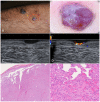Clinical, Dermoscopic, Ultrasonographic, and Histopathologic Correlations in Kaposi's Sarcoma Lesions and Their Differential Diagnoses: A Single-Center Prospective Study
- PMID: 36615078
- PMCID: PMC9821103
- DOI: 10.3390/jcm12010278
Clinical, Dermoscopic, Ultrasonographic, and Histopathologic Correlations in Kaposi's Sarcoma Lesions and Their Differential Diagnoses: A Single-Center Prospective Study
Abstract
(1) Background: Kaposi's sarcoma (KS) is an angioproliferative neoplasm typically appearing as angiomatous patches, plaques, and/or nodules on the skin. Dermoscopy and ultrasonography have been suggested as an aid in the diagnosis of KS, but there is little evidence in the literature, especially regarding its possible differential diagnoses. Our aim is to describe and compare the clinical, dermoscopic, and ultrasonographic features of KS and KS-like lesions. (2) Methods: we conducted a prospective study on 25 consecutive patients who were first referred to our tertiary care center from January to May 2021 for a possible KS. (3) Results: 41 cutaneous lesions were examined by means of dermoscopy, Doppler ultrasonography, and pathology, 32 of which were KS-related, while the remaining 9 were lesions with clinical resemblance to KS. On dermoscopy, a purplish-red pigmentation, scaly surface, and the collarette sign were the most common features among KS lesions (81.3%, 46.9%, and 28.1%, respectively). On US, all 9 KS plaques and 21 KS nodules presented a hypoechoic image. Dermoscopic and Doppler ultrasonographic findings of KS-like lesions, such as cherry angioma, venous lake, glomus tumor, pyogenic granuloma, and angiosarcoma were also analyzed. (4) Conclusions: dermoscopy and Doppler ultrasonography can be useful to better assess the features of KS lesions and in diagnosing equivocal KS-like lesions.
Keywords: Kaposi’s sarcoma; clinical manifestations; dermoscopy; differential diagnoses; histopathology; ultrasound imaging.
Conflict of interest statement
The authors declare no conflict of interest.
Figures







References
-
- Brambilla L., Genovese G., Berti E., Peris K., Rongioletti F., Micali G., Ayala F., Della Bella S., Mancuso R., Calzavara Pinton P., et al. Diagnosis and treatment of classic and iatrogenic Kaposi’s sarcoma: Italian recommendations. Ital. J. Dermatol. Venerol. 2021;156:356–365. doi: 10.23736/S2784-8671.20.06703-6. - DOI - PubMed
-
- Brambilla L., Boneschi V., Taglioni M., Ferrucci S. Staging of classic Kaposi’s sarcoma:A useful tool for therapeutic choices. Eur. J. Dermatol. 2003;13:83–86. - PubMed

